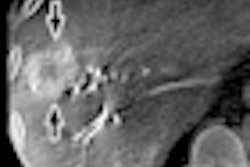Dr. Jeffrey Belair, a resident at the University of Pittsburgh Medical Center (UPMC), and colleagues gathered data from 60 cases (30 biopsy-proven malignancies, 10 biopsy-proven benign lesions, and 20 normal cases) that were imaged with both noncontrast CBCT and DBT. For the study, six breast imagers evaluated each case twice, once with CBCT and once with DBT; Belair's group calculated specificity and sensitivity of cancer detection for both modalities.
Sensitivity and specificity of tomosynthesis for malignancy were 0.87 and 0.81, respectively, while sensitivity and specificity of noncontrast CBCT for malignancy were 0.70 and 0.67. Although noncontrast CBCT doesn't currently have a role in assessing noncalcified breast lesions, the study findings suggest that as the technology advances and readers become more familiar with it, this may change, according to the researchers.



















